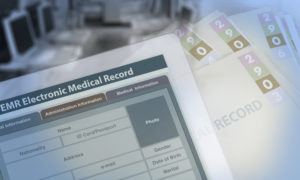By Danny Clarke, OD

May 17, 2017
An effective office work flow ensures patients move through the practice efficiently, with plenty of time to shop in the optical, and fast enough for you to see the maximum number of patients per day, helping you build profitability. My four-OD, 22-support staff practice in Wichita Falls, Texas, is always alert to the need to improve our office flow to create a more convenient, pleasing experience for patients, and a more profitable practice.
Patients assume things should work smoothly and efficiently, from check-in, to pre-testing, exam, optical and check-out. It is our job to keep our ears to the ground to make sure we are able to deliver, and even, exceed that expectation.
Gauge How Long from Start to Finish
Our patients want streamlined, convenient visits to our office. To do that, we try to have patients fill out paper work ahead of time online, which can save up to 10 minutes when the patient first arrives.
Instead of filling out the paperwork, the information they enter online gets automatically uploaded to their electronic health record. We set the link on our web site up through our practice management software, Compulink.
After the patient checks in, and we ensure that we have all necessary information on file, or filled out, the key steps for us are: pre-test, exam room for the comprehensive exam, the optical with handoff to an optician who reviews and fills the doctor’s prescription, contact lens review and ordering (if the patient is a contact lens wearer) and check-out.
Our average time from start to finish, including time in the optical and contact lens ordering, is about 70 minutes. I feel that’s too long, and we would like to cut the process back to 45-50 minutes. I would like to give the patient at least 30 minutes for shopping in our optical without them having to spend more than an hour in our office altogether.
Our practice sees an average of about 65 patients per day, including all visit types. On average, we do about 35 comprehensive exams per day across the practice with our 2.5 full-time equivalent doctors.

Seven members of Dr. Clarke’s 22 support staff members. Dr. Clarke says your support staff can be a big help in identifying problem areas in your work flow, and brainstorming ways to resolve those issues.
Here’s the average patient visit time break-down in our office:
Check-in: 10 minutes
Pre-test (includes contact lens evaluation and quote): 25 minutes
Wait time for doctor: 10 minutes
Exam: 15 minutes
Check-Out: 5 minutes or less
Evaluate Whether Office Space Needs Changes
We had a small pre-testing room in which we could only do one pre-test at a time. This became a creator of patient bottlenecks, so we remodeled in 2014 to move some exam rooms, and added an 18 ft. x 20 ft. pre-testing room in which we can have five patients pre-testing at the same time. This improved pre-testing efficiency, but pushed the bottleneck problem to our six exam rooms. So, in 2015, we built an addition to our office space, and now have 11 exam rooms. We were land-locked, and could do a maximum of 11 lanes. We use three per doctor for regular patient flow, and the other two for overflow, or for specialty clinics, such as my dry eye clinic.
Sometimes changing patient care needs challenges office flow. For instance, we found that dry eye visits were slowing us down, especially when we added LipiFlow at the end of 2016. To solve this work flow issue, we added a separate dry eye-specific clinic four hours per week in which we can offer dry eye-focused care while minimizing disruption of office flow for our other patients.
Add Scribes
We utilize scribes for each doctor. This has been a game changer for three primary reasons. First, scribes enable increased efficiency for data entry, especially with all of the details for each patient that must be entered to meet Meaningful Use requirements. Secondly, patient perception of doctor face-time increases with scribes, even though less time may actually be spent with the patient. With a scribe in the room, the doctor can be eye-to-eye with the patient the entire exam, rather than spending half the exam with their back turned to the patient doing data entry. Last, overall patient flow improves due to increased exam room efficiency.
It isn’t as much a question of staff size as it is a philosophy and understanding that the more efficient the examination process is, the more effective the doctor can be communicating with the patient. The results are seen with happier doctors, more satisfied patients and increased sales due to more focused doctor/patient education time. As long as collections per hour increases by the scribe’s salary and benefits, the practice is not spending extra money for the scribe. When utilized properly, I would argue that scribes are an asset instead of an expense, and offer a good return on investment.
Ask Support Staff for Input
Our team spends more time with our patients than the doctors do, so their input on work flow issues is essential. We all have the goal to provide excellent service to our patients, and when our people see or hear that we are delivering anything less, we want them to let us know so we can improve.
They are critical to helping us solve work flow issues, as they are usually the ones who feel the pressure when we are running behind and see the patients’ frustration. We hope our team will always bring up issues they see, especially when they are recurring. They are expected to be aware, and let leadership know their thoughts. We make it a priority to discuss patient flow challenges at our regular staff meetings, and to work on solutions together.
 Danny Clarke, OD, owns Clarke EyeCare Center in Wichita Falls, Texas, which was just ranked on Entrepreneur Magazine’s Top Company Cultures list. They have also received an All-Star award by The Great Game of Business and were named the Family-Owned Business of the Year for the SBA Dallas/Ft. Worth district, which comprises 72 counties in Texas. Dr. Clarke is also the President of MODUS Practice in Motion, which offers open-book management training to optometric practices. To contact him: dbc@clarkeeye.com
Danny Clarke, OD, owns Clarke EyeCare Center in Wichita Falls, Texas, which was just ranked on Entrepreneur Magazine’s Top Company Cultures list. They have also received an All-Star award by The Great Game of Business and were named the Family-Owned Business of the Year for the SBA Dallas/Ft. Worth district, which comprises 72 counties in Texas. Dr. Clarke is also the President of MODUS Practice in Motion, which offers open-book management training to optometric practices. To contact him: dbc@clarkeeye.com



























